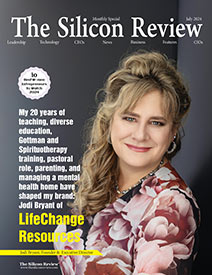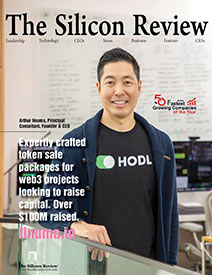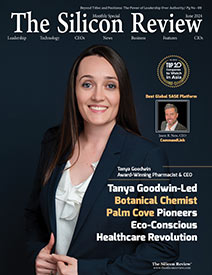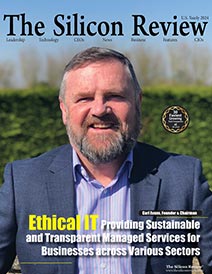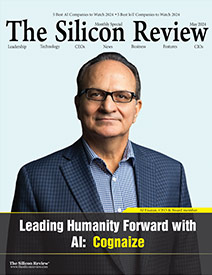50 Fastest Growing Companies Of The Year 2019
Innovation Insurance Group Founder Ty R. Sagalow Cracks Open Why Insurance Industry Needs Lemonade Insurance-Style Business Model
The Silicon Review
![]()
“Lemonade Insurance virtually eliminated all paperwork.”
Innovation Insurance Group was formed in 2012 by Ty R. Sagalow, a 36-year-old veteran of the insurance industry. Mr. Sagalow abandoned an extremely successful executive career in Corporate America to start his own firm. In the past seven years, IIG has grown to a seven-figure revenue firm annually specializing in innovation consulting in the industry. With well over 100 client engagements, Mr. Sagalow has helped start numerous new companies, making Innovation Insurance Group, LLC well deserving of being chosen to be one of our 50 Fastest Growing Companies of the Year.
No doubt, the most well-known company Mr. Sagalow help create is Lemonade Insurance where he was a founding member and Chief Insurance Officer. In this article, he talks about what lessons the insurance industry can learn from Lemonade.
Lemonade: Synopsis
This article is not about how to best make a popular summer drink but rather about a startup insurance company formed by two foreign nationals who had no knowledge or training in insurance but who somehow managed to create a new type of insurance company which captured six percent of its chosen market in New York city within nine months of its launch and became nationally-known as the “Uber of Insurance”. The current value of the company is reported to be in excess of $2 Billion after less than three years of operation.
Lemonade is part of the “InsurTech” phenomenon; some say the latter helped create the former. InsurTech has attracted over $8.5 Billion in investments from 2014 to 2018 and ushered in a new way of conducting insurance operations.
Ty R. Sagalow: In His Own Words
I am Ty Sagalow, one of the founding members of Lemonade and its Chief Insurance Officer. While Lemonade is a Property and Casualty insurance carrier with a product line of renters, homeowners and coop/condo insurance, its lessons apply to any type of insurance company, or indeed any company that through innovation and the sheer will-power desires to change the status quo.
The idea of Lemonade started in May 2015 when two Israeli technology executives decided that there was a fundamental flaw in the insurance industry. While they knew absolutely nothing about insurance, they were aware that people generally hated the insurance industry. The Urban Dictionary defines the insurance industry as “an industry that involves selling promises to people to pay later which are never fulfilled.” Professional Dan Ariely, the noted behavioral economist expert out of Duke University, has stated that “if you tried to create a system to bring out the worse in humans, it would look a lot like insurance today.” One of the chief reasons for this is that the insurance industry is the only industry that has as part of its core business model a conflict of interest between the provider of the service and its customer. Simply put, every dollar an insurance company does not pay in a claim is another dollar of profit for the insurance company, which brings us to Lesson number one:
- Eliminate the Inherent Conflict of Interest between Insurance Carriers and their Customers
Lemonade did this by turning the insurance carrier model into a SaaS (Software-as-a-Service) one. Lemonade takes a fixed percentage (approximately 25 percent as of today) of every dollar of the premium received. There is no “profit-sharing” in profitable years, no increase in compensation when claims are not paid. It is the same fixed fee no matter what. Of course, this model does not work for every company. However, the concept behind the model is critical. The key to a successful insurance company, it seems to me, is to try to align the interests of the insurance carrier with its policyholder. In doing this, insurance carriers must create and maintain, to use a Lemonade phrase, a “sweet and delightful experience” for its insureds. This starts right from the application stage, through the life of the policy and to the final claims payment, which brings us to our second lesson:
- Use Technology to Create a Sweet and Delightful Experience for your Insureds
Lemonade does this right from the beginning by creating a friendly, extremely efficient “chatbot” to acquire application information from the applicant, a process the company calls “onboarding” taking the name for client acquisition from the technology sector. Through the applicant’s chat interaction with AI (Artificial Intelligence) Maya, Lemonade is able to obtain the few missing pieces of information which it then combines with data from third-party sources to provide a quote to the applicant instantaneously.
However important it is to create an initial pleasant experience for your insured during the onboarding process, it is absolutely vital to do so at the time of the claim, and this is where the Lemonade model can be especially illuminating. A Lemonade insured submits his or her claim via their phone. No claim forms. No fax machine. The only way to submit a claim is through your smartphone and again it is via a chatbot not a formal claims submission as it is known in the industry today. For example, part of the claims submission process is to simply video record what happened. AI Jim, the artificial intelligence sibling of Lemonade’s Chief Claims Officer, James Hageman, analyzes the claim information, compares it to the insured’s policy, runs a number of anti-fraud algorithms, and if it deems there is coverage, and if the claim is simple enough, AI Jim will authorize and actually make payment. How fast? AI Jim’s record so far – three seconds, which brings us to lesson number three:
- Use Technology to Reduce Cost to the Benefit of the Insured
Lemonade virtually eliminated all paperwork. It is amazing how much money you can save if you eliminate paper. In addition, Lemonade does not use any outside brokers or agents. The 25 percent SaaS fee mentioned earlier, the only fee Lemonade takes, goes to a wholly-owned subsidiary, Lemonade Insurance Agency. Eliminating independent brokers and agents may not work for every company. However, the concept of using technology to reduce the costs in the system, whether that cost is incurred directly or indirectly by the carrier through higher commissions to its insurance agents remains critical. For example, a carrier might create broker/agent technology that streamlines the process your brokers have to go through saving them time and money and potentially justifying a lower commission.
An important feature of this cost reduction strategy is that it is the insured, and not the carrier or the broker, that should benefit the most from the use of technology. For Lemonade, savings through technology directly reduces the premium for its insurance policies. Indeed, for renter’s insurance
where the expense ratio is a much bigger factor in premium calculation than the loss ratio, Lemonade’s ability to use technology to reduce costs results in a renter’s policy premium as low as $5 per month, less than half of Lemonade’s competition.
Yet the efficiencies of technology and the elimination or reduction of the inherent industry conflict of interest should not only help the insured but society in general, which brings us to lesson number four:
- Make the World a Better Place by Turning Insurance from a “Necessary Evil”
Back to a Social Good
Insurance was originally created as a social good. Society needed to take risks, be innovative to grow and prosper. Ships needed to venture into the new world. New medicines had to be created to reduce disease and prolong life. But with these new advances came new risks. Insurance was meant as society’s mechanism to spread those risks among all its habitants. However, somewhere along the line, insurance ceased being about “we” and became about “them vs us”, a zero-sum game where for the insurance carrier to win, the insured had to lose. In essence, insurance ceased to be a social good and became a necessary evil.
Remember the flat 25 percent fee model that Lemonade uses and its refusal to add one penny to its pocket when there is a “good year” in claims payments. This model immediately prompts the question that if Lemonade is not taking the “excess profits” in good risk years for themselves, what happens to the money? In Lemonade’s case, it donates 100 percent of this “excess profit” to charity. When an applicant finishes its “application” for insurance, it is given a list of 15 charities to choose from. Each insured who chooses the same charity is then grouped as a “cohort”. If the loss results of the members of a cohort in any given year is profitable (defined as a loss ratio of less than 40 percent), the excess (the percentage between the actual loss ratio and 40 percent) is donated to the charity selected by that cohort. This is called the “Annual Giveback” and occurs every July.
Of course, insurance carriers don’t have to follow the exact “Giveback” model that Lemonade uses to share the good results of its insureds in a way that helps society. The exact method can be as flexible as the creative mind. The key is for the insurance company to be a true partner in the communities it serves.
For the “Giveback” to best work, Lemonade had not to only change its own potential “conflict of interest” behavior (by adopting a SaaS revenue model) but also needed to try to change the behavior of its insureds (to reduce “insurance fraud” and thus generate more unearned monies for the charities). That is our “final” lesson:
- Help Insureds be on their Best Behavior through Behavioral Economics
I have already discussed how Lemonade sought to avoid the temptation to deny claims in order to make more money for itself through a “Ulysses contract” in which it tied its hands by announcing that it would donate 100 percent of all “excess monies” to the charities selected by its policyholders. However, bad behavior goes both ways and as Professor Ariely aptly pointed out insurance has a tendency to bring out the worst in all of us, including policyholders. Thus, lesson #5 is to create an atmosphere where your policyholders are more likely, to be honest in the information they provide to you. Lemonade does this by implementing a number of behavioral economics techniques favored by Professional Ariely who happens to be Lemonade’s Chief Behavioral Officer. One of these is to remind the insured before they start to describe the claim they wish to submit that although they should feel comfortable claiming every dollar they deserve if they try to claim undeserved monies they are only robbing funds from the charity they chose to support. In addition, before describing their claim, they also sign (with their finger on their phone) an “honesty statement” saying that everything they are about to describe is truthful. This is in sharp contrast to all traditional insurance claim forms which only require the insured’s signature after they have completed the forms and told whatever lies they have chosen to tell. It will be years before Lemonade knows whether the processes it created to help bring out the best in its insureds’ behavior have actually decreased its “insurance fraud” rate but the lesson here is nevertheless a good one: understand that like you, your insureds are only human and, like all of us, sometimes need a gentle push toward being the best version of ourselves.




